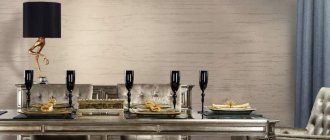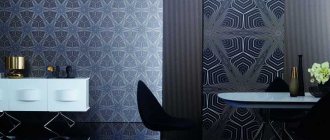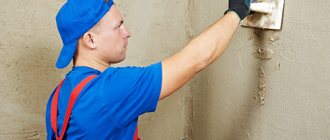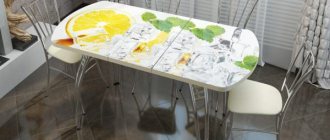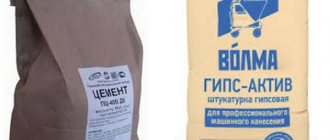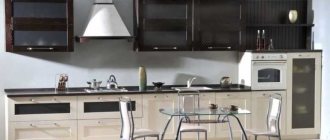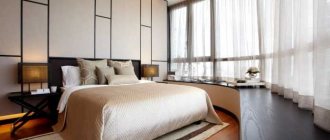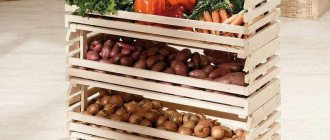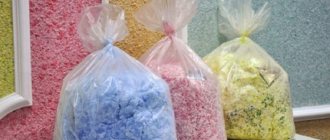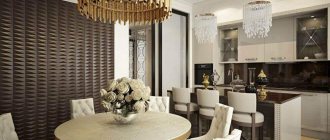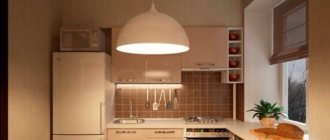Advantages and disadvantages of plastering
There are many advantages to using decorative putty in the kitchen interior, but there are also disadvantages.
Interesting! The disadvantages arise from the type of mixture, each has its own.
| Advantages | Flaws |
| Apply to different types of surfaces (iron, wood, concrete). | The mineral type of putty may develop cracks if the building being repaired does not settle. But the cracks are simply sealed. |
| After all the operations, there are no seams left and the result is a spacious room, not divided into segments. | It costs a lot (especially silicone), and if you are not a professional you will need a lot of it. |
| There is no need to carefully level the walls before plastering. It will all level out on its own, and for the Venetian, a small relief is even welcome. | Mineral putty can only be painted in a snow-white shade. |
| The composition allows the walls to “breathe” due to the free movement of air. | Acrylic putty should not be applied over slabs because toxic substances may be released. |
| If the recipe contains minerals, then they do not allow mold, bacteria and fungi to multiply. | Before using the silicate type, it is necessary to prime the walls with a special solution using a complex technique. |
| Long service life and strong resistance to various negative influences. | |
| Ease of restoration. If a small part is damaged, there is no need to putty the entire surface again. |
Despite the large number of disadvantages, there are many more advantages. An additional advantage is its relevance in different designs, which is why it is in demand in kitchen decoration.
Advantages and disadvantages of using decorative plaster in the kitchen interior
The decorative composition can be used to cover both individual parts of the kitchen space and entire walls. The exception is the work area (apron). Venetian plaster in the kitchen perfectly divides it into functional areas: dining and working.
The composition includes natural materials and is suitable for use in the kitchen.
The main advantages include:
- imitation of natural structures thanks to a wide palette of colors;
- does not require preparatory work before applying the coating;
- masking defects and unevenness of walls;
- resistance to humidity, temperature changes, mechanical stress and the influence of aggressive cleaning agents;
- retains texture and primary color under any conditions;
- durability (15-20 years);
- no joints and seamless coating (as a result, the walls are less susceptible to abrasion);
- fire safety;
- does not absorb foreign odors;
- versatility (suitable not only for residential, but also for office premises);
- environmental friendliness;
- unpretentious care;
- natural ingredients make it possible to apply the mixture in children's institutions and hospitals;
- simple application technology.
Among the many advantages, there are also disadvantages:
- the material is not elastic, which increases the likelihood of cracks appearing after drying;
- high price;
- difficult dismantling (difficult to remove from walls);
- Doesn't go well with a lot of decor.
Depending on the composition, decorative plasters may have certain performance characteristics and appearance.
Advice! To give the appearance of the walls a greater marble effect, the plaster is applied in several shades (2-3).
Selecting the palette and textures
Decorative plaster for interior wall decoration is selected depending on the volume of the room. The larger it is, the more texture and relief is allowed. There will be no difficulties in choosing the right color, because there are approximately 2000 shades of colors. The colors can be selected from a catalog or in a store with a consultant to match the tone of the set, dining table, chairs, curtains, etc.
The mixture is produced in two consistencies: powder and paste. The dry powder is diluted in water to the required consistency immediately before puttying. Once the mixture has hardened, it cannot be diluted, so do not dilute it too much. Ready-made pastes are sold in sealed containers, so they are not afraid of rapid hardening. But after opening, if stored improperly, the solution may harden, so it is better to use it immediately without any residue.
The most popular color for kitchen decoration is snow-white. It is used in many styles. With it you can get brickwork suitable for the Scandinavian style.
Beige is also often used for decoration. Venetian plastering can be used to create a classic or neoclassical kitchen apron.
For bright new styles, a green tone is suitable. It is not necessary to plaster the entire area with it. It is enough to focus, for example, on the dining area.
Violet, pink and lilac colors can create a more relaxed and gentle atmosphere in spacious rooms.
Charcoal decorative plaster for the kitchen is used for high-tech, minimalism, loft. Moreover, the walls should be smooth or with slight relief.
Grayish shades are used for minimalism, high-tech, modern and loft.
Blue and turquoise tones are suitable for Provence, country, and Mediterranean style. They go well with white shades and small floral prints.
The rest of the bright colors are carefully selected so that the furniture and decor look harmonious.
The stucco molding and frescoes look very stylish. But it is very difficult to obtain them on your own. That's why it is prescribed to masters.
Traditional and modern composition of the Venetian
The composition of traditional decorative plaster includes marble dust, slaked lime (a binding component) and water.
In modern compositions, other components can be used - granite, onyx, granite, quartz, sand, artificial dyes. And artificial elements are added as a binder - polymers, acrylic resins.
The finishing layer, wax, is designed not only to protect the coating from moisture and dirt, but also to give the surface a characteristic shine.
Today you can buy decorative plasters in the form of ready-mixes in a specialized store, which will greatly simplify the task of preparation and application.
The traditional color of Venetian plaster, which together with the texture serves as its distinctive feature, is golden, beige, light brown.
But because Modern production technologies allow you to add any color to the mixture, so you can achieve absolutely any color and shade. Although in this case, only one feature will remain from the traditional version - the characteristic pattern.
Peculiarities of work - expert advice
To ensure that working with decorative solutions does not seem very complicated, you need to take into account some nuances:
- It is necessary to prepare the walls as best as possible for puttying. A smooth finish will not work on very textured walls. And some textured putties will also not fit as they should.
- Plastering is more expensive than wallpapering or painting. Therefore, take this into account when planning your renovation. Always be prepared that you may need a new portion.
- Textured designs and deep reliefs require more material compared to smooth surfaces. This also needs to be taken into account when planning repairs. For example, acrylic type is required for 1 sq.m. on average from 2.5 kg. up to 3kg. But each manufacturer has different recommendations, you need to rely on the instructions.
- To save on putty, you can choose a primer mixture with deep penetration. But it is necessary to look for compatible ones so that the work does not crumble or become deformed. This primer will additionally protect against mold and fungi, because it contains a fungicide and an antiseptic.
- For distribution, you can use any movements (long, short, crosswise, longitudinally, smoothly, roughly). You can even roll it out with a tool in different directions or with gloved hands. To get the same effect, 1 person must distribute everything in the room.
- The solution will harden within 2 weeks. And until it dries completely, you need to be extremely careful so as not to spoil the plastering.
- Due to the rapid hardening, quick work is required, so it is better to do everything together. For example, the first will apply, and the second will distribute and create relief.
- To maintain a pleasant appearance for a long time, everything is treated with acrylic varnishes or protective wax. They increase service life, prevent cracking, make the surface more resistant to moisture, and make the coating shiny, emphasizing the relief.
Types of decorative plaster for the kitchen
Depending on the type of connecting element, texture and external surface, several varieties of Venetian plaster are distinguished.
Venetian, textured and structural plaster is used in the kitchen.
By base type
The difference is determined by connecting elements:
- classic (consists of components such as marble chips, a binder and additives that give the composition strength);
- mother-of-pearl (the composition contains reflective particles that create optical effects);
- textured (a special application technique allows you to imitate natural stone, wood and other materials);
- polymer (it is characterized by improved adhesion to the base, fits well on concrete, plasterboard, primed metal, MDF; gypsum plaster is used as a base);
- lime (lime-based mixture has better vapor permeability).
A composition based on cement and lime is called mineral. The silicate mixture contains quartz chips. The binding component is silicone or acrylic.
Marble finishing, made on the basis of plaster mixtures, is quite practical and economical compared to natural stone.
By design and application technique
One composition can recreate several different textures. One of them is a flat, classic surface. Relief plaster has a greater number of application techniques:
- craquelure (giving the surface an artificial age in the form of cracks by applying a special craquelure varnish);
- carrara (applied in several layers, each of which differs by half a tone from the previous one);
- coating with veins (the effect is provided by bituminous marble chips, tinted with soot);
- Trevignano (a polymer mixture and a special coating technique create the effect of a marble wall, simulating illumination from the inside by the sun);
- encausto (recreation of a matte surface);
- marbello (the surface resembles velvet with glossy veins);
- imperiale (the gold pigment included in the composition shimmers in sunlight);
- wet silk (expensive fabric effect).
Venetian plaster consists of stone dust, a binder, a dye and allows you to play with color and relief.
For reference! Under the influence of external weather conditions, the plaster can crack, thereby losing its decorative and operational properties.
Decorative plaster under stone
Decorative type of plaster easily replaces artificial and natural materials. Concrete, clay, gypsum, lime and other compounds are used for finishing. As a result, you can imitate malachite, granite, marble and other stones.
Textured plaster can include craquelure, or an artificially aged coating with cracks.
There are several coating creation techniques.
- Flat. Smooth plaster recreates stones such as granite, marble, polished stone wall. A perfectly smooth surface is coated with a wax composition and then polished.
- Textured. The appearance resembles a large solid stone with a rough surface.
- Flat-relief. Designed in the form of stonework. The seams are indicated by a slight groove. Imitation of brick or stone blocks is possible. In this case, the surface of the wall is flat.
- Convex. Molds are used that recreate the most realistic drawing.
The combination of glossy and matte veins, as well as pearlescent coating creates the effect of a natural material.
Stone plaster goes well with other building materials.
A decorative coating that has a granular structure due to the inclusion of insoluble granules or special fibers in the material is called structural.
Decorative plaster for concrete
The material is characterized by some features: it has a rough surface and a porous structure due to the content of sand and stone chips. To achieve relief, the plaster is applied in several layers.
A decorative coating with a concrete effect can be made using special compounds, such as microcement, decorative art concrete or regular cement mortar.
There are two main types.
- Microcement. The composition is a cement-polymer mixture without quartz chips. Suitable for finishing concrete, wood, metal, plastic surfaces and ceramic tiles.
- Microconcrete. The base of the mixture is cement. Contains quartz chips, dyes and polymer additives. The composition does not absorb odors, is heat-resistant, and also has hygroscopicity and high plasticity.
There is a wide selection of gray, beige, white, and sometimes rusty shades.
Decorative concrete coating can be used in any interior. The material has good sound insulation and water resistance. Due to the low level of thermal conductivity, the energy efficiency of the room increases. Types of decorative plaster and their compatibility in the kitchen can be viewed in the photo.
Plaster with glossy or metallic pigment creates the effect of wet silk in the kitchen interior.
The best photos of real examples
In order to choose the most beautiful plastering, look at examples of real photos in the interior:
Peculiarities
This type of decorative coating will be appreciated by those who prefer classic design. In addition, such finishing gives any room a luxurious and expensive look with high performance characteristics of the coating. For kitchen premises, an important feature is the moisture resistance of materials, and certain varieties of Venetian have exactly this property.
The coating itself consists of several translucent layers applied one on top of the other. It is the multi-layering that provides the unique visual effects for which Venetian plaster is so valued.
However, such coatings have another important feature - they are difficult to apply, therefore, it is not worth taking on such work without experience in handling Venetian or artistic talent. Errors in application can be quite expensive due to the high cost of plaster mixtures of this type.
The high price is a consequence of the fact that such solutions use expensive ingredients in the form of natural marble, malachite or granite flour, as well as the need to create quite a lot of layers of material. There is a way to reduce repair costs by using certain types of mixtures that are applied in a minimum number of passes.
